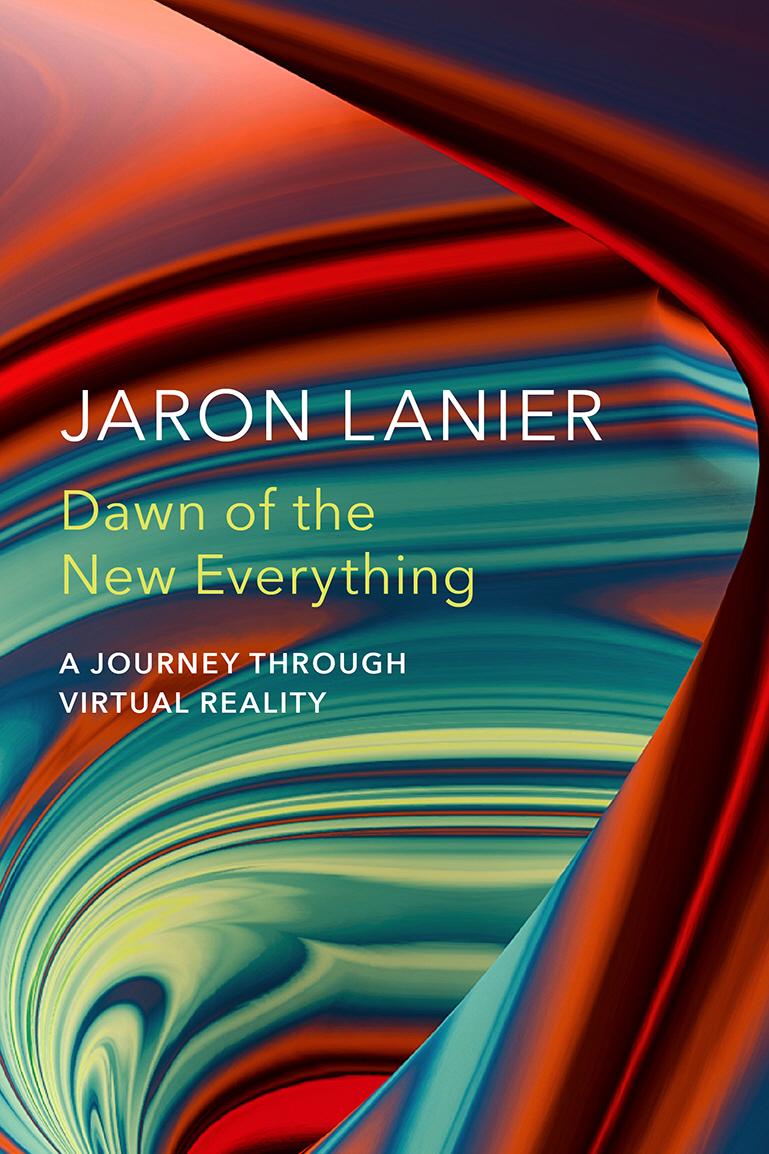Jaron Lanier: Dawn of the New Everything review - pioneer of virtual reality tells his story | reviews, news & interviews
Jaron Lanier: Dawn of the New Everything review - pioneer of virtual reality tells his story
Jaron Lanier: Dawn of the New Everything review - pioneer of virtual reality tells his story
A fascinating story involving pictures of techie beards - and too many lists

Jaron Lanier has quite a story to tell. From a teenage flute-playing goat-herd in New Mexico to an “intense dreamer”, and a maths student capable of arguing, about films for example, with “supremacist. Borgesian flair”, then onwards and upwards, there is much to fascinate.
With friends he founded the first virtual reality start-up company VPL Research in 1984, and has co-founded three other start-ups – those stories are not told here. He has been involved with Microsoft since 2006 and currently has the title of Interdisciplinary Scientist at Microsoft Research. He is also a musician and composer who has performed with Yoko Ono, Philip Glass and Ornette Coleman, and a band which he led once opened for Bob Dylan at the Montreux Jazz Festival in the 1990s.
 Lanier is credited with having invented the phrase "virtual reality" and there is no doubt that he wants to define it his way, to refer to the hardware that he has spent decades working on, and to pull back from any lazy uses of the phrase as a metaphor. To this end he reproduces a complete article he wrote in 1999 for Whole Earth Review in which he makes a long list of the wilder and egregious uses of "virtual reality" as a “moniker on the loose”, belittling those who dare to imply that the phrase means things like “a delinquent association from the truth” or an “ecstasy or epiphany brought about by technology”.
Lanier is credited with having invented the phrase "virtual reality" and there is no doubt that he wants to define it his way, to refer to the hardware that he has spent decades working on, and to pull back from any lazy uses of the phrase as a metaphor. To this end he reproduces a complete article he wrote in 1999 for Whole Earth Review in which he makes a long list of the wilder and egregious uses of "virtual reality" as a “moniker on the loose”, belittling those who dare to imply that the phrase means things like “a delinquent association from the truth” or an “ecstasy or epiphany brought about by technology”.
If in doubt – which he very seldom is – his method is often to make a list. The idea that “engineers are drawn to headset optics by its seductive landscape of engineering challenges” produces a footnote replete with 14 bullet-points. The book is peppered right through with no fewer than 51 different definitions of VR, the last of which gives an insight into Lanier’s fundamental idealism: “The medium that can put you into someone else’s shoes; hopefully a path to increased empathy.”
That thought left me wondering about what kind of character can keep hold of dreams when he has lived through the whole history of Silicon Valley, the feeding frenzy of tech bubbles and land-grabs. But he has. He seems almost wilfully naïve and uncynical about business, about real-world applications, far more inclined to pursue a philosophical quest for “meaning” in the technology. He spends one chapter cheerleading for VR while debunking Artificial Intelligence, but once his arguments veer into the areas of quantum cryptography and phrenotropic architecture, I had to admit to being out of my depth.
That said, Lanier never loses sight of the things and the people he worships. There is a veneration for the superior kind of techie, he always has a word of praise for those he has known for their ability to write computer code, and his section on the early Eighties in Silicon Valley is enjoyable. He remembers “dreaming in code” and “coding in my sleep”, while a happy band of fellow coders were struggling with relationships, sushi and laundry. The book is packed with black-and-white photos of people, gloves, headsets, and myriad varations on the techie beard. And then there is the surrounding California culture: “The VR party universe overlapped with the psychedelic one and the Grateful Dead one.” Indeed, Jerry Garcia’s daughter and a lyricist for The Dead make cameo appearances in the narrative.
The book’s title Dawn of the New Everything had made me hope I would learn more about areas of society, of industries where Virtual Reality has already changed everything, such as military training/surveillance or surgery, but in each case the subject is dealt with in a couple of very lightweight pages, which end summarily. Take Lanier’s fleetingly brief memory of contracts from the military. It ends with a bathetic envoi, almost like a bored child talking: “But back to happy stories of early VR apps.” Any sense of how VR has already affected particular industries, and how one might use that as a guide to how it might then move forward is missing.
Perhaps the least surprising thing about this book is the timing of its publication, presumably driven by expectations of exponential growth in sales for Virtual Reality/Augmented Reality hardware in the next few years. According to some forecasts from specialist consultancies, it could be a $150-200 billion worldwide market by 2021 (from a mere $6 billion in 2016).
Dawn of the New Everything is at its best a joyous ride through the pioneer days in Silicon Valley. But Lanier’s Who Owns the Future?, published in 2013, was a far stronger, more unified, more passionate and thought-provoking book.
- Dawn of the New Everything - A Journey through Virtual Reality by Jaron Lanier (Bodley Head , £20)
- More book reviews on theartsdesk
rating
Explore topics
Share this article
more Books
 Heather McCalden: The Observable Universe review - reflections from a damaged life
An artist pens a genre-spanning work of tender inconclusiveness
Heather McCalden: The Observable Universe review - reflections from a damaged life
An artist pens a genre-spanning work of tender inconclusiveness
 Dorian Lynskey: Everything Must Go review - it's the end of the world as we know it
Authoritative account of how the apocalypse has always been just around the corner
Dorian Lynskey: Everything Must Go review - it's the end of the world as we know it
Authoritative account of how the apocalypse has always been just around the corner
 Andrew O'Hagan: Caledonian Road review - London's Dickensian return
Grotesque and insightful, O’Hagan’s broad cast of characters illuminates a city’s iniquities
Andrew O'Hagan: Caledonian Road review - London's Dickensian return
Grotesque and insightful, O’Hagan’s broad cast of characters illuminates a city’s iniquities
 Annie Jacobsen: Nuclear War: A Scenario review - on the inconceivable
Brimming with terrifying facts and figures, but struggling with an immeasurable subject
Annie Jacobsen: Nuclear War: A Scenario review - on the inconceivable
Brimming with terrifying facts and figures, but struggling with an immeasurable subject
 Anna Reid: A Nasty Little War - The West's Fight to Reverse the Russian Revolution review - home truths
Reid brings to light a war the West has tried its best to forget
Anna Reid: A Nasty Little War - The West's Fight to Reverse the Russian Revolution review - home truths
Reid brings to light a war the West has tried its best to forget
 Tom Chatfield: Wise Animals review - on the changing world
A compelling account of how we use technology – and how it uses us
Tom Chatfield: Wise Animals review - on the changing world
A compelling account of how we use technology – and how it uses us
 Sheila Heti: Alphabetical Diaries review - an A-Z of inner life
Heti goes far beyond a gimmick in this work of surprising and moving insight
Sheila Heti: Alphabetical Diaries review - an A-Z of inner life
Heti goes far beyond a gimmick in this work of surprising and moving insight
 David Harsent: Skin review - our strange surfaces
A fine poet pens a set of resilient expressions and elegant introspections
David Harsent: Skin review - our strange surfaces
A fine poet pens a set of resilient expressions and elegant introspections
 Brian Klaas: Fluke review - why things happen, and can we stop them?
Sweeping account of how we control nothing but influence everything
Brian Klaas: Fluke review - why things happen, and can we stop them?
Sweeping account of how we control nothing but influence everything
 Richard Schoch: Shakespeare's House review - nothing ill in such a temple
Scholar makes the Bard's house a home in his history of dramatic domesticity
Richard Schoch: Shakespeare's House review - nothing ill in such a temple
Scholar makes the Bard's house a home in his history of dramatic domesticity
 Richard Dorment: Warhol After Warhol review - beyond criticism
A venerable art critic reflects on the darkest hearts of our aesthetic market
Richard Dorment: Warhol After Warhol review - beyond criticism
A venerable art critic reflects on the darkest hearts of our aesthetic market
 Best of 2023: Books
As the year draws to a close, we look back at the best books we opened
Best of 2023: Books
As the year draws to a close, we look back at the best books we opened

Add comment